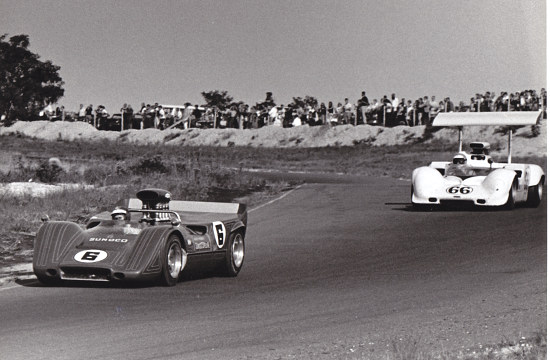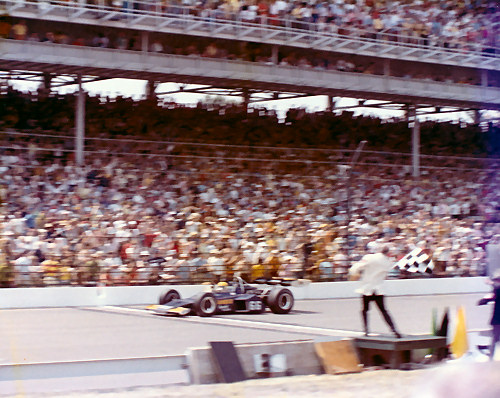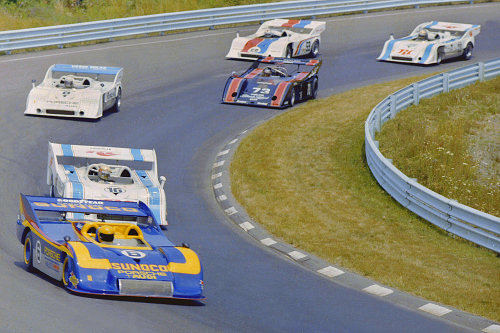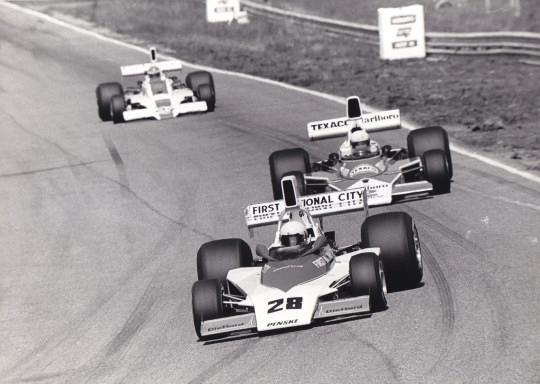The Way It Is/ Remembering the great Mark Donohueby Gordon Kirby |
 Forty years ago this week we lost Mark Donohue. Penske Racing's original team leader died in Austria on August 19th, 1975 after crashing two days earlier in the morning warm-up for that year's Austrian GP. Donohue's car flew into and over the guardrail following a front tire failure and his helmet was struck by a catch fence post.
Forty years ago this week we lost Mark Donohue. Penske Racing's original team leader died in Austria on August 19th, 1975 after crashing two days earlier in the morning warm-up for that year's Austrian GP. Donohue's car flew into and over the guardrail following a front tire failure and his helmet was struck by a catch fence post.
He was knocked out but came around at the scene of the accident although he soon complained of a severe headache before losing consciousness on the way to hospital. Despite an operation on Sunday night to relieve pressure on his brain Donohue never regained consciousness and died two days later. An injured marshal also died. As everyone knows, Donohue was Penske Racing's original number one driver and team leader. He was the man who made Penske Racing happen in its formative days from 1966-'75 as he won the United States Road Racing Championship in 1967 and '68, took three Trans-Am championships in 1968, '69 and '71 and won the 1973 Can-Am title in Penske's incredible Porsche 917/30K. Donohue also scored Penske's first Indy car victory at Pocono in 1971 and the first of the team's 16 Indy 500 wins in 1972.  © Racemaker An engineering graduate from Rhode Island's Ivy League Brown University, Donohue was not only Penske's number one driver but also the team's chief engineer and team manager as well as occasional truck driver and floor sweeper. Donohue worked with a tiny team of six or eight people led by chief mechanic Karl Kainhofer in Can-Am, Indy and Formula 5000 cars, and Leroy Gane and John Woodard on the Trans-Am cars and long-distance sports cars. Donohue started racing in 1959 aboard a Corvette and raced an Elva Courier in 1960 and '61, winning the SCCA's E Production championship in '61. Over the next four years he raced a variety of cars including an Elva Formula Junior, a TVR Grantura, a rare rear-engined Cooper-Offy midget, a Shelby Cobra, an MGB, a NART Ferrari 250LM and a Shelby Mustang. In 1965 Donohue won Watkins Glen's mid-summer 500-mile sports car race, co-driving a Shelby Mustang with Walt Hansgen, and the following year he shared a factory Ford mk II with Hansgen at Daytona and Sebring, finishing third at Daytona and second at Sebring. Donohue was very much a thinking man's race driver. In fact, everything about Donohue's approach to the sport caught the eye of Hansgen's old friend Roger Penske who had run a Corvette entered by Penske Chevrolet in the 1966 Daytona 24 hours with Dick Guldstrand, George Wintersteen and Ben Moore driving. At Sebring, Penske entered a pair of Corvettes and convinced Sunoco to provide some sponsorship. After those races Penske persuaded Sunoco to help buy a Lola T70 Can-Am car from Lola distributor John Mecom and thus was born Penske Racing. Penske hired Donohue to drive and the new team won three races that year--a USRRC race at Kent, Washington in July; round three of the inaugural Can-Am series at Mosport in September; and the Tourist Trophy at Nassau in December. The following year Donohue and Penske won the USRRC title and they also raced in the Can-Am and Trans-Am series. In 1968 Donohue repeated as USRRC champion, won the Trans-Am title and finished third in the Can-Am behind the factory McLarens. Penske also made his first move into Indy cars in '68 with Donohue racing an Eagle-Chevy in a pair of USAC road races at Mosport and Riverside.  © Penske Restoration/Dave Friedman In 1970, Penske's primary effort went into running a pair of AMC Javelins in the Trans-Am series for Donohue and Peter Revson. At Indianapolis Donohue raced a Lola-turbo Ford, finishing second to Al Unser with Dan Gurney third. Donohue ran three other USAC races that year and also raced a Lola-Chevy in three SCCA Formula 5000 races, winning at Mosport and Sebring. In '71 Donohue's plate was extremely full. He won Penske's third Trans-Am championship, this time for American Motors; co-drove Penske's Ferrari 512M with David Hobbs at Daytona, Sebring, Le Mans and Watkins Glen; ran the Canadian and United States GPs in a Penske-prepared McLaren M19, finishing third in his F1 debut at Mosport; raced an F5000 Lola in the Questor Grand Prix in California; and ran nine USAC Championship races, Indy 500 included. Penske and Donohue switched to McLaren's new wedge-shaped M16 Indy car in '71 and Donohue scored Penske's first Indy car win in the Pocono 500 in July and also won a 200-mile race at Michigan two weeks later. Donohue and teammate Gary Bettenhausen dominated the Indy 500 in 1972 with Bettenhausen leading 138 laps and looking a sure winner until a magneto failure stopped him barely 20 laps from the end. Donohue ran second or third most of the way and went on to score Penske's first win at the Speedway in the team's fourth attempt. Three weeks after winning the Indy 500 Donohue crashed while testing Penske's Porsche 917/10 Can-Am car at Road Atlanta when the rear bodywork broke loose while he was in the fastest section of the track. The 917/10 hit the bank hard, cartwheeled down the road and comprehensively destroyed itself. Donohue was lucky to escape with nothing worse than a broken left leg, but he was out of action for a couple of months. George Follmer replaced Donohue in the Can-Am Porsche and went on to win the championship. Donohue returned to action for the year's last four races in a second Penske 917/10 and won at Edmonton after Follmer had to stop to replace a punctured tire.  © Dennis Torres Donohue also ran the SCCA's Formula 5000 series in a Lola with an underpowered and unreliable AMC engine and competed in only two USAC races--the Indy and California 500s--but didn't finish either one because of engine failures. At the end of 1973 Donohue won two of the first three IROC races run at Riverside before wrapping-up the inaugural IROC championship on the road course at Daytona in February of '74. Donohue then announced his retirement but he was unhappy out of the cockpit working as team manager and came back in September to debut Penske's new F1 car at the Canadian and United States GPs. In 1975, Donohue ran the full F1 World Championship schedule, but the Penske PC1 was off the pace and was replaced late in the year by a March 751. At the third race with the March at the Osterreichring in August Donohue lost his life after crashing in the morning warm-up. Donohue's car tore down more than 50 yards of catch-fencing and went over the guardrail, striking a marshals' post before coming to a stop. Donohue's helmet was hit by a catch fence post and he suffered a concussion but was otherwise uninjured. The car was badly damaged and marks on the road suggested its left front tire had failed. Over the ten years that Donohue led Penske Racing he won 60 of 180 races he started in Can-Am, Trans-Am, Formula A/5000, Indy cars, NASCAR and Formula 1. Karl Kainhofer looks back with great pride on the decade he spent as Donohue's chief mechanic. "You can compare Penske Racing's Donohue years to the best of any other race team in history," Kainhofer remarks. "It was so different with Mark compared to working with anybody else. You didn't need anybody else. He made his own decisions about how to set up the cars and how to run them. From day one of testing all the way through to the race weekends and the races Mark decided what we were going to do.  © Dan Boyd Comments John Woodard: "It was almost a 24-7 job in those days. I lived close enough to the shop where I was in early every morning and I would always come home for half an hour to have lunch with the family. Then I'd go back to work 'till 5.30, then come home for dinner and maybe run the kids through the bathtub and then go back and work 'till 10 or 10.30. That was typical, especially when we were building the cars and getting ready for the season. "It was hard work, but everybody did it. Nobody put in more hours or worked harder than Mark Donohue. He was there when you got there and he was there when we left. So it was hard work but it was fulfilling because Mark would get us anything we wanted. Whether it was a tool, a part, a fitting, he made sure we had whatever we needed. And it was fulfilling because we were winning races." Ron Fournier is one of America's most renowned race car builders and fabricators. Fournier worked for Penske Racing from 1966-'69. During that time he built all the team's Trans-Am cars and produced many major components for Penske's Can-Am and Indy cars. "Donohue was an incredible guy," Fournier says. "He could manage the handling of the car to his liking. He would set the ride heights and all that so it was just right. When we started running the Camaros we had a problem getting the rear of the car to sit low enough. So we went down to Philadelphia to a spring shop and got the rear springs re-arched. He watched how they did it and when we got back he found out one was a little different than the other. "That was close enough for the average guy but Mark said this is no good for us. He said he was going to learn how to arch the rear springs. So he had me make up a special fixture so he could do the job himself. We took two round bars of steel about six inches long and welded them to a giant vise about eight inches apart. We would put the spring over that and hit it with a sledgehammer to give it more arch. If we wanted less arch we would turn it over and hit it that way.  © David Phipps "I don't ever remember using a blueprint or a drawing. Everything was done right off the top of our heads. Mark might make a sketch of where he wanted the main chassis pieces to be or how he wanted a suspension pick-up point moved down. He had all those things worked out in his mind. We did it all pretty much by the seat of our pants but it all worked. "And of course, he tested. He ran the cars on the skid pad. He ran the bejesus out of those cars before he ever took them to the racetrack. He balanced the cars really well before we left for the track. He was way ahead of most people in those days. He came across to a lot of people as a young, dumb kid, but he wasn't. He was a very smart man." Donohue was only 38 when he died. Had he survived he surely would have contributed a great deal more to Penske Racing's history. But his legacy remains as one of America's greatest racers and a key founding father of the country's most successful and definitive race team. |
|
Auto Racing ~ Gordon Kirby
Copyright ~ All Rights Reserved |
